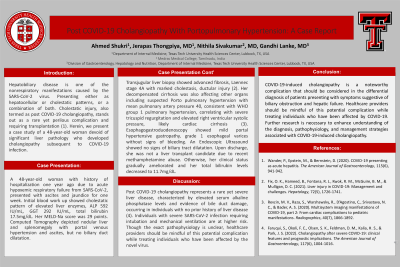Tuesday Poster Session
Category: Liver
P4712 - Post COVID-19 Cholangiopathy With Portopulmonary Hypertension: A Case Report
Tuesday, October 29, 2024
10:30 AM - 4:00 PM ET
Location: Exhibit Hall E

Has Audio

Ahmed Shukri, MD
Texas Tech University Health Sciences Center
Lubbock, TX
Presenting Author(s)
Ahmed Shukri, MD1, Jerapas Thongpiya, MD1, Nithila Sivakumar, MD2, Gandhi Lanke, MD1
1Texas Tech University Health Sciences Center, Lubbock, TX; 2Medras Medical College, Lubbock, TX
Introduction: Hepatobiliary disease is one of the nonrespiratory manifestations caused by the SARS-CoV-2 virus. Presenting either as hepatocellular or cholestatic patterns, or a combination of both. Cholestatic injury, also termed as post COVID-19 cholangiopathy, stands out as a rare yet perilous complication and requiring transplantation. Herein, we present a case study of a 48-year-old woman devoid of significant liver pathology who developed cholangiopathy subsequent to COVID-19 infection.
Case Description/Methods: A 48-year-old woman with history of hospitalization one year ago due to acute hypoxemic respiratory failure from SARS-CoV-2, presented with ascites and jaundice for one week. Initial blood work up showed cholestatic pattern of elevated liver enzymes, ALP 592 IU/mL, GGT 292 IU/mL, total bilirubin 17.5mg/dL. Her MELD-Na score was 29 points. Computed Tomography depicted nodular liver and splenomegaly with portal venous hypertension and ascites, but no biliary duct dilatation. Her serum-ascites albumin gradient was more than 1.1 with a high protein level of 3.1g/dL. Transjugular liver biopsy showed advanced fibrosis, Laennec stage 4A with marked cholestasis, ductular injury. Her decompensated cirrhosis was also affecting other organs including suspected Porto pulmonary hypertension with mean pulmonary artery pressure 40, consistent with WHO group 1 pulmonary hypertension, correlating with severe tricuspid regurgitation and elevated right ventricular systolic pressure, likely cardiac cirrhosis. Esophagogastroduodenoscopy showed mild portal hypertensive gastropathy, grade 1 esophageal varices without signs of bleeding. An Endoscopic Ultrasound showed no signs of biliary tract dilatation. Upon discharge, she was not a liver transplant candidate due to recent methamphetamine abuse. Otherwise, her clinical status gradually ameliorated and her total bilirubin levels decreased to 11.7mg/dL.
Discussion: Post COVID-19 cholangiopathy represents a rare yet severe liver disease, characterized by elevated serum alkaline phosphatase levels and evidence of bile duct damage, occurring in individuals with no prior history of liver disease. Individuals with severe SARS-CoV-2 infection requiring intubation and mechanical ventilation are at higher risk. Though the exact pathophysiology is unclear, healthcare providers should be mindful of this potential complication while treating individuals who have been affected by the novel virus.
Disclosures:
Ahmed Shukri, MD1, Jerapas Thongpiya, MD1, Nithila Sivakumar, MD2, Gandhi Lanke, MD1. P4712 - Post COVID-19 Cholangiopathy With Portopulmonary Hypertension: A Case Report, ACG 2024 Annual Scientific Meeting Abstracts. Philadelphia, PA: American College of Gastroenterology.
1Texas Tech University Health Sciences Center, Lubbock, TX; 2Medras Medical College, Lubbock, TX
Introduction: Hepatobiliary disease is one of the nonrespiratory manifestations caused by the SARS-CoV-2 virus. Presenting either as hepatocellular or cholestatic patterns, or a combination of both. Cholestatic injury, also termed as post COVID-19 cholangiopathy, stands out as a rare yet perilous complication and requiring transplantation. Herein, we present a case study of a 48-year-old woman devoid of significant liver pathology who developed cholangiopathy subsequent to COVID-19 infection.
Case Description/Methods: A 48-year-old woman with history of hospitalization one year ago due to acute hypoxemic respiratory failure from SARS-CoV-2, presented with ascites and jaundice for one week. Initial blood work up showed cholestatic pattern of elevated liver enzymes, ALP 592 IU/mL, GGT 292 IU/mL, total bilirubin 17.5mg/dL. Her MELD-Na score was 29 points. Computed Tomography depicted nodular liver and splenomegaly with portal venous hypertension and ascites, but no biliary duct dilatation. Her serum-ascites albumin gradient was more than 1.1 with a high protein level of 3.1g/dL. Transjugular liver biopsy showed advanced fibrosis, Laennec stage 4A with marked cholestasis, ductular injury. Her decompensated cirrhosis was also affecting other organs including suspected Porto pulmonary hypertension with mean pulmonary artery pressure 40, consistent with WHO group 1 pulmonary hypertension, correlating with severe tricuspid regurgitation and elevated right ventricular systolic pressure, likely cardiac cirrhosis. Esophagogastroduodenoscopy showed mild portal hypertensive gastropathy, grade 1 esophageal varices without signs of bleeding. An Endoscopic Ultrasound showed no signs of biliary tract dilatation. Upon discharge, she was not a liver transplant candidate due to recent methamphetamine abuse. Otherwise, her clinical status gradually ameliorated and her total bilirubin levels decreased to 11.7mg/dL.
Discussion: Post COVID-19 cholangiopathy represents a rare yet severe liver disease, characterized by elevated serum alkaline phosphatase levels and evidence of bile duct damage, occurring in individuals with no prior history of liver disease. Individuals with severe SARS-CoV-2 infection requiring intubation and mechanical ventilation are at higher risk. Though the exact pathophysiology is unclear, healthcare providers should be mindful of this potential complication while treating individuals who have been affected by the novel virus.
Disclosures:
Ahmed Shukri indicated no relevant financial relationships.
Jerapas Thongpiya indicated no relevant financial relationships.
Nithila Sivakumar indicated no relevant financial relationships.
Gandhi Lanke indicated no relevant financial relationships.
Ahmed Shukri, MD1, Jerapas Thongpiya, MD1, Nithila Sivakumar, MD2, Gandhi Lanke, MD1. P4712 - Post COVID-19 Cholangiopathy With Portopulmonary Hypertension: A Case Report, ACG 2024 Annual Scientific Meeting Abstracts. Philadelphia, PA: American College of Gastroenterology.
